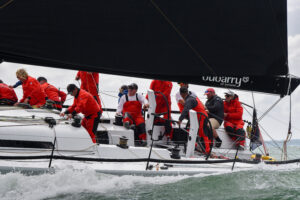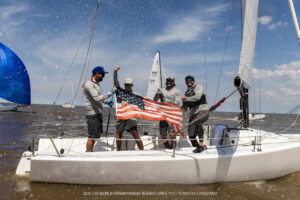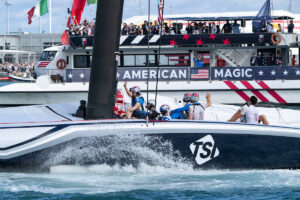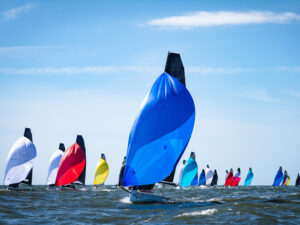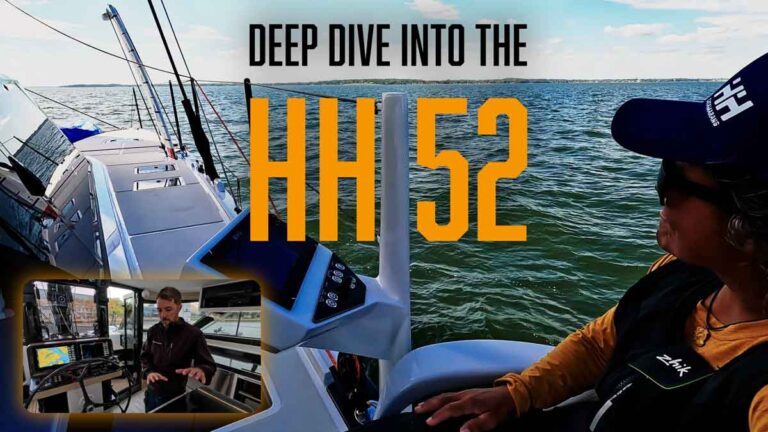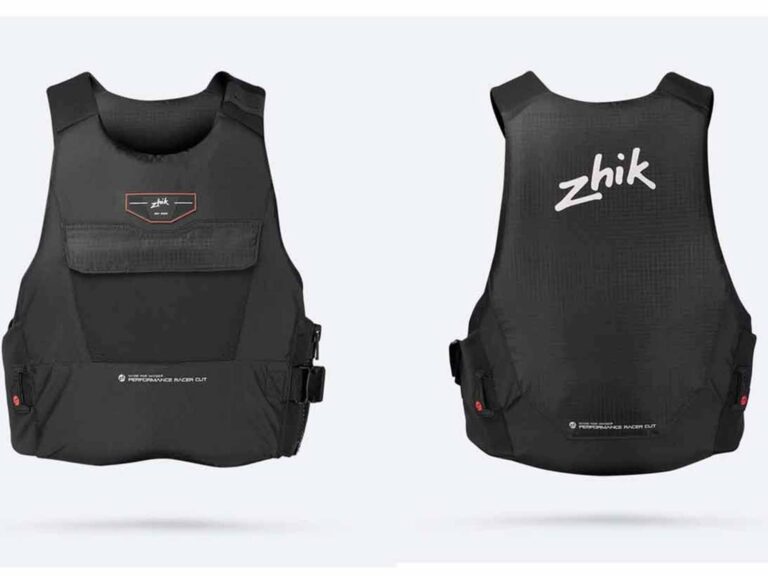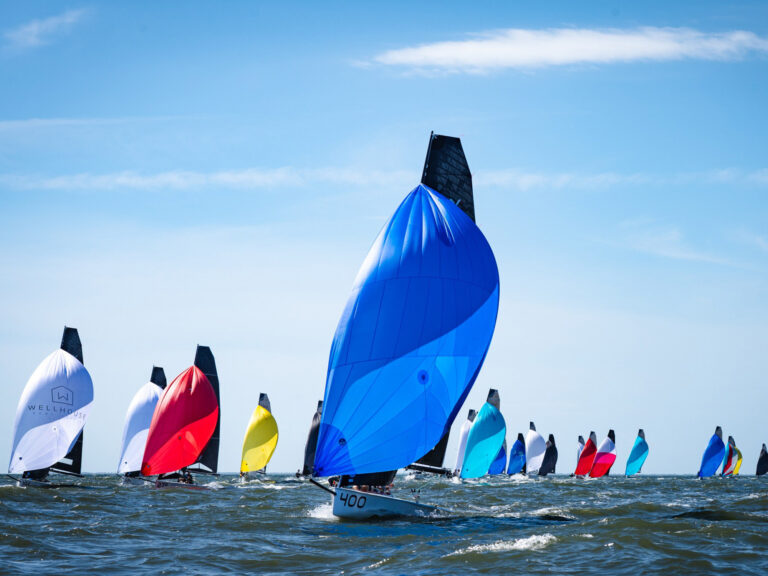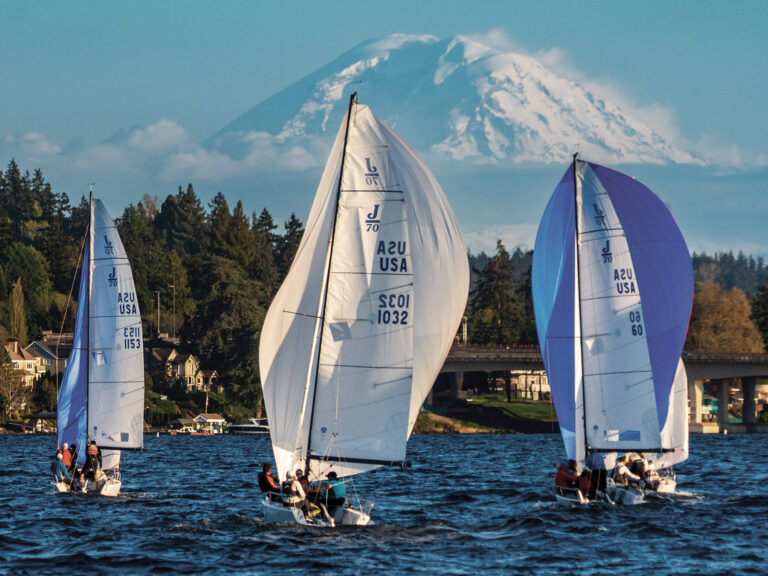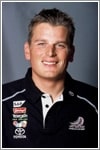
As Team New Zealand’s menacing black yacht swept across the finish line for the fifth and final time in its 2000 America’s Cup defense, Dean Barker raised his left hand from the wheel and punched the sky. His face streaming with rainwater and spray, he unleashed a howl of triumph and pumped his fist into the air repeatedly. In NZL-60s wake trailed the Italian yacht, Prada, comprehensively beaten. Barker and the Team New Zealand crew had delivered the ultimate prize to a nation that worships sport in general and follows sailing with an avid and informed eye. But the victory was also intensely personal for Barker, for in that memorable instant, ghosts that had haunted the young helmsman for much of his short career were laid to rest.
Later that day, Barker and his mentor, Russell Coutts, whod steered the first four races of the finals, hoisted the Americas Cup aloft in front of a throng of adoring fans. So much symbolism was encapsulated in that shared moment. Coutts would be praised for his generosity, stepping aside for his young protégé at the climax of the Cup Match. He spoke of a Cup dynasty stretching 25 years or more into the future. The torch was being passed on, and Barker was now the golden boy of New Zealand yachting. He would skipper the next defense, backed by Coutts, tactician Brad Butterworth, and the accumulated sailing and design talent of one of the most powerful sailing teams in modern history.
But Barker barely had a moment to enjoy the limelight. Soon the Team New Zealand empire started crumbling around him: Coutts and his top lieutenants headed to Europe; designer Laurie Davidson and a stream of others went to the United States. In the midst of this storm of defections, and with only design coordinator Tom Schnackenberg left to run the program, Barker was thrust into the breach to help rebuild a viable lineup to defend the Cup in 2003. Days and weeks of working the phone lines followed as they rallied the remaining troops, cajoling and persuading the waverers, and recruiting new members. These were stressful times, but Barker also continued racing and maintained Team New Zealands–and his own–momentum on the match-race circuit. Only three months after the Americas Cup, he traveled to Croatia and won the world match-race championship.
Equally impressive was the way in which Barker handled his new role. People still talk of how much he matured in those first six months after the Cup victory. Others see it differently. “Sometimes you give a person a role and ask him to do things hes never done before,” says Schnackenberg. “When he does them well, youre pleased and surprised, but its not necessarily that hes changed or matured. Its just that an opportunity has opened up and hes taken it. Dean obviously has a strong and consistent confidence in himself. He doesnt waver. What was impressive for me was that those qualities were there in somebody so young.”
From somebody as astute as Schnackenberg thats a reassuring analysis, because there have been those who doubted Barkers mental toughness. When Coutts handed him the helm of NZL-60, some observers held their breath. They worried how Barker might react if, with the eyes of the world on him, he blew this golden opportunity, and what impact it would have on him. Those questions were not born of malice, but out of concern for a young sailor whod struggled under pressure before, first at the 1993 Laser Worlds and then at the New Zealand Finn Trials for the 1996 Olympics.
Barker grew up on Auckland’s North Shore and went through the classic New Zealand sailing progression, starting with Optimists and then advancing through the unique P class singlehander that’s bred so many Kiwi champions.
In his second year in the class, Barker won the coveted P class double, taking the Tanner and Tauranga Cups. “That was my first major achievement in sailing,” he says. “Thats perceived to be a crucial stepping stone in New Zealand yachting.” After a brief and instructive stint in New Zealands then star-studded 470 fleet, Barker returned to singlehanders, this time in Lasers. Although hes tall, now nearly 64″, and 190 pounds, Barker was always light for his size. After a couple of losses in heavy air, he got his act together, making up for a lack of weight with fitness and technique. In 1990, confident and motivated, he won the Youth Worlds in Muiden, Holland, without having to sail the final race.
During the next year, Barker won several regattas, but later recognized he was losing his edge. “I was my own worst enemy,” he admits. “I cruised. I was complacent.” When asked about his second-place finish at the 1991 Youth Worlds, he says, “I made up a million excuses, but at the end of the day, I was resting on my laurels. Youre only as good as your last race. Its something Ive learned over and over again.”
In a number of ways, it was a huge learning period for Barker. The Worlds were part of a whole European adventure. Barker and his former schoolmate Hamish Pepper traveled the Laser circuit together in a yellow VW van, sleeping on the beach or in the carparks of regatta venues, living rough, but going through a vital rite of passage.
“Those were great times,” says Pepper. “We often look back on it and laugh at how much we enjoyed our sailing. They were pretty carefree days, but we had a serious goal, first of getting into the top 10 at the Worlds and ultimately of winning.” Both of them performed well through Europe and felt poised to excel at the 1993 Laser Worlds, sailed on the familiar waters of Aucklands North Shore.
The regatta started well enough and, with two races to go, a pack of sailors was jammed at the top of the fleet. Barker was among them, .5 points off the lead, and poised to make a move. But then, disaster. “In the last two races, I just sailed horribly,” he says. “In my own mind, there was no way I could possibly finish outside of the top three.” Instead, he finished 10th–a huge letdown.
Thoroughly demoralized, he quit Lasers for Finns and took up the new challenge of toppling the class incumbent, Craig Monk, bronze medalist at the Barcelona Games and the favorite for the New Zealand berth in the 1996 Olympics. “Id just lost interest in Lasers altogether,” says Barker. “I was blown away by what happened and couldnt face sailing in Lasers again.”
Back to Europe went Barker, this time with a Finn and without the companionship of Pepper, who continued in Lasers. In the midst of his Finn training, though, Barker had a brief introduction to Americas Cup racing when Coutts invited him to train with Team New Zealand before the 1995 Cup regatta. Barker spent about five months with the team during its preparations in Auckland, but declined an invitation to sail on the B boat in San Diego. His sights were still set on an Olympic medal.
In Auckland at the Finn trials, a remarkable drama unfolded. Against all expectations, Barker dominated the early rounds, working himself into a position where, with two races to go, he needed just one finish of fourth or better to make the team.
Again, the clutch performance–and success–eluded him. “I went into defensive mode and sailed really badly,” he says. “I went from having basically won it, to losing it. I was totally blown away.” Barker, who lists “bad golf” and motor racing–he campaigns a 240-horsepower Ford–as his leisure distractions, seriously considered quitting sailing. “I just couldnt stand that feeling of losing, and losing badly like that,” he says. “I was in a depression for weeks afterwards. It was the most painful period of my life.”
In the aftermath of his Olympic debacle, it was Pepper who came to the rescue. He’d won the Laser selection for Savannah and asked Barker to coach him. It proved a perfect antidote for the blues.
Then, just before the Games got under way, Barker got a call from Coutts, who said he wanted him to stand in as mainsheet trimmer on his match-race team. Though Barker had done a little match racing in Auckland, it was his first taste of the international circuit. “I just loved it,” he says. “I really enjoyed that style of short, intense racing.” Coutts invited him back to Team New Zealand, and this time he was totally committed, first earning a spot in a rather crowded afterguard, but always hankering to drive a boat.
The way to achieve that goal seemed obvious, if daunting: He had to prove he was good enough to take over for Murray Jones and Richard Dodson, and the way to do that was by winning match-race events. So, from within the Team New Zealand ranks, the Young Guns crew was created in 1998. As they began to reap some exceptional results–beating Jones in the New Zealand Nationals, second to Coutts in the Steinlager Line 7 regatta, winning the Australia Cup, third in Croatia, third in Sweden, second to Paul Cayard at the 1999 Steinlager Line 7–Barker began to get a share of the wheel on Team New Zealands tune-up boat.
To achieve so much in match racing so quickly points to a special ability. “Match racing requires a certain spatial awareness,” says Schnackenberg. “An ability to visualize a lot of scenarios at once. Some people just cant do it, their brain doesnt work that way. But Dean has it. That was one of the first clues that he possesses a very good mind.” Coutts was encouraging, but also demanding, urging Barker to get his match-racing skills up another level. In an effort to lift his game, Barker brought Pepper onboard as a tactician.
|
|
| |
|
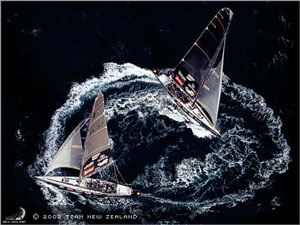
|
| |
| Courtesy Team New Zealand|
| |
|
|
| |
| Just like in 2000, Team New Zealand has used a steady diet of high intensity in-house racing to prepare for its Cup defense in mid February.* * *|
| |
|
|
|
Soon they were beginning to get somewhere, and when Coutts decided he wanted Jones in his own afterguard, the job of driving the B boat fell solely to Barker. For days and months, Coutts and Barker sparred out on the Hauraki Gulf, and steadily the accounts of those battles began to leak out with a consistent theme–the pupil was giving the master a torrid time.
“There was never an official score,” says Barker diplomatically. “It was good for Russell to get beaten. The worst thing would have been for him to be able to win easily.
“We are both fiercely competitive and there were no holds barred. There were collisions. It wasnt friendly; it was all on. But Russell was excellent all the way through.
“We both kept our eyes on the big picture and that was the Cup. It wasnt as if I was challenging him for his position. I wanted him to be as good as he could be. The future would provide me with my chance.” Which it did, of course, though somewhat sooner than expected, on that March morning when Coutts took Barker aside and asked him if he would like to steer NZL-60 in the fifth race against Prada. “I couldnt say no,” says Barker. “I had to give it a go. I recognized there would be serious consequences in doing it and not winning. But, if you dont take chances like that, you may as well move on to something else.”
Moving onto anything other than the Americas Cup holds no interest for Barker right now. “This is my total focus,” he says. This is as it should be. Instead of just concentrating on the skippers role, supported by a wealth of talent, he now has the management of the sailing team.
Younger than many of his crew, he wears his leadership lightly, yet clearly has earned the respect of his peers. “He has a huge load on his shoulders,” says Pepper. “But, hes a born leader. Hes very smart and he knows how to get the best out of the guys.”
Barker anoints the memories of his disappointments with as much respect as his more numerous triumphs. “You learn so much more from a bad loss than a good win,” he says. “Ive had two real-life lessons, each slightly different but with the same outcome. I imagine Ill always look back and recognize them as the best things that could have happened, even if they were painful at the time. I never want to endure that again, but if it wasnt for those defeats, I wouldnt be working as hard as I am now.”

